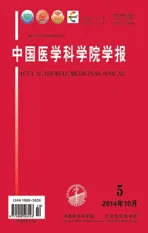二肽基肽酶-4在造血和移植中的作用
2014-01-25李德冠孟爱民
李德冠,孟爱民
中国医学科学院 北京协和医学院 放射医学研究所天津放射医学与核医学重点实验室,天津300192
造血系统是一个高度分化的系统,其中,造血干细胞 (hematopoietic stem cells,HSC)和造血祖细胞(hematopoietic progenitor cells,HPC)发挥重要作用。造血干祖细胞 (hematopoietic stem and progenitor cells,HSPC)主要受体液免疫调节,包括细胞因子、趋化因子以及刺激细胞增殖的正调控因子,如:促红细胞生成素、集落形成刺激因子 (colony-stimulating factor,CSF)和白细胞介素等。虽然大量研究已经阐明了这些调节因子在细胞和细胞内的作用,但对于这些因子在疾病或应激状态下的功能改变仍有待进一步研究。近来研究发现,二肽基肽酶 (dipeptidyl peptidase,DPP)-4能够作用于一些与造血系统调节有关的趋化因子、克隆刺激因子和白细胞介素因子,提示DPP-4抑制可在造血系统及移植过程中发挥重要作用。本文总结了DPP-4抑制在造血系统和骨髓移植中的作用研究进展。
DPP4的结构和分布
DPP-4是1966年 Hopsu-Havu等[1]在鼠肝脏组织匀浆中发现的一个蛋白酶、相对分子质量为110 000,是丝氨酸蛋白酶家族中的一种,分布于细胞表面,含有766个氨基酸,其三维晶体结构在2003年由Lambeir等[2]研究证实。DPP是丝氨酸蛋白酶家族的一个亚群,主要包括DPP-4、成纤维激活蛋白-α(fibroblast activation protein-α,FAP-α)、DPP-8 和 DPP-9,其作用底物仍有待进一步发现。DPP-4分为两种形式:一种可在细胞表面表达CD26;另一种为可溶性分子,缺少细胞内部分和转膜结构域,两种DPP-4均具有酶活性。DPP-4的活性部分是Asp—His—Ser节段,其活性体为二聚体,每个亚单位包含2个结构域,凡是结构的 N端为Xaa-Pro-或Xaa-Ala-的多肽都是 DPP-4发挥活性的主要底物[3-4]。
可溶性DPP-4存在于血清/血浆、脑脊髓液、关节液和精液中,具有跨膜结构的DPP-4则在多种组织的内皮和表皮细胞中表达,包括骨髓细胞、静脉血管、胃肠道、肝脏、胰腺、肺、肾脏、前列腺等。此外,DPP-4还在胚胎干细胞、HSC、HPC以及其他多种成熟血细胞中表达[5]。
DPP-4的抑制
目前全球已有西格列汀 (sitagliptin)、维格列汀(vildagliptin)、沙格列汀 (saxagliptin)、阿格列汀(alogliptin)、利格列汀 (1inagliptin)、吉格列汀(gemigliptin)和替格列汀 (teneligliptin)7种DPP-4抑制剂上市,其中,西格列汀、维格列汀和沙格列汀已在我国上市,阿格列汀和利格列汀已在我国提出临床申请,吉格列汀在我国由LG Life Sciences授权双鹤制药开发。这些DPP-4抑制剂主要作为治疗2型糖尿病的口服降糖药物,通过抑制活性胰高血糖素样肽-1(glucagon like peptide-1,GLP-1)的降解失活,提高其浓度,增强其生理作用,促进β细胞胰岛素的分泌、抑制α细胞的胰高血糖素分泌,改善胰岛功能的紊乱,同时没有增加体重和低血糖的风险,不良反应少见[6-7]。
对DPP-4的调节作用机制目前尚未明确。Khurana等[8]研究发现,给予HSPC组织因子途径抑制物 (tissue factor pathway inhibitor,TFPI)可有效抑制DPP-4活性,增加细胞对CXCL12(SDF-1)的趋化性,进而提高归巢和植入能力。对GPC3-/-小鼠的研究发现,其HSPC增殖能力增加,而HSC自我维持能力下降,骨髓细胞表现出DPP-4高表达,从而使进入循环的HSPC增加,骨髓中干祖细胞池数目降低。GPC1-/-小鼠未发现上述变化。这些结果证实,TFPI可通过磷脂酰肌醇蛋白聚糖-3(glypican-3,GPC-3)抑制DPP-4的活性。
DPP4抑制对细胞移植的调节作用
Christopherson等[9]研究发现,DPP4在 G-CSF动员小鼠HPC中可发挥介导作用,并进一步证实DPP-4在小鼠HSC归巢和植入中起调节作用。此后,研究人员在子宫内HSC移植、逆转录HPC移植等多个实验中,均证实DPP-4可在造血细胞移植中发挥作用,抑制DPP-4有利于造血细胞的归巢和植入[10-12]。
Prabhash等[13]观察了CD26在肿瘤患者或捐赠者动员外周血干细胞中的表达,结果发现CD26的表达与白细胞植入效果相关,有作为植入早期检测指标的可能。植入缓慢一直是临床脐带血移植难以克服的巨大难题,因为这一过程中会降低HSPC数目。Farag等[14]在临床造血疾病患者1个单位脐带血移植过程中使用了DPP-4抑制剂西格列汀,24例患者 (21~58岁)在接受清髓处理后,在-1 d到+2 d每天口服600 mg西格列汀,在第0天接受移植,临床监测获得较好的植入效果,中性粒细胞植入时间的中位数为21 d。该研究为临床脐带血移植时应用DPP-4提供了基础,利用西格列汀抑制DPP-4活性的剂量和时间仍有待进一步优化。而DPP-4抑制在其他如肌源性干细胞、原位单肺等移植中也有一定作用[15-16]。
DPP-4抑制对造血细胞的调节作用
Broxmeyer等[17]研究发现,DPP-4可调节 G-CSF功能影响造血系统,进而引发DPP-4在造血系统作用的关注。有研究显示,通过diprotin A(ILE-PRO-ILE)或缬氨酸-焦谷氨酸 (VAL-PYR)等多肽小分子抑制HSPC上DPP-4的活性,进而通过提高细胞对趋化因子CXCL12的趋化性,可提高HSPC的归巢和植入能力[18-19]。DPP-4剪切后的CXCL12缺失了趋化功能,但是能够抑制全长CXCL12发挥作用。Broxmeyer等[17]研究发现,接受DPP-4剪切后的细胞因子无论是在体内还是体外,其促进造血细胞的增殖能力都大幅下降,并会降低其相应全长因子的活性。而在DPP4-/-小鼠或者正常小鼠接受照射或者化疗前给予DPP-4抑制剂西格列汀,均有助于小鼠的造血系统恢复。现在临床上用于动员HSPC的G-CSF,其N末端起始位点是蛋氨酸,改变了原来的序列,进而能够逃过DPP-4的剪切。Christopherson等[20]则发现,来自脐带血、骨髓还是动员外周血的单个核血细胞都表达DPP-4,利用diprotin A处理过的细胞均能有效增加对趋化因子 CXCL12的趋化性。但在 CD26-/-小鼠和diprotin A预处理抑制DPP-4的小鼠中,G-CSF对造血细胞的动员能力反而下降,其机制有待进一步阐明。
巨核细胞可通过促血小板生成素受体 (antithrombopoietin receptor,c-MPL)直接影响HSC的静止或者通过分泌因子间接影响HSC的增殖与存活。而对DPP4-/-小鼠研究发现,尽管DPP-4敲除未对外周血计数产生明显作用。但在DPP4-/-小鼠骨髓中,无论是巨核细胞 (lin-CD41+CD61+)还是巨核祖细胞 (lin-CD41+CD61+C-kit+Sca-1-)的数目都有显著提高,提示DPP-4的缺失或者抑制有益于巨核细胞的发育,但机制尚未明确[21]。
DPP-4抑制对造血微环境的调节作用
造血微环境是HSC赖以生成的场所,造血细胞在微环境各种因素的调控下增殖、分化、发育及成熟。Ou等[22]利用NCBI数据库和通用蛋白资源 (universal protein resource,UniProt)寻找的氨基酸序列找到了近百个具有DPP-4切除位点的分子。这些分子有许多是能够调节造血细胞的趋化因子和生长因子,如成纤维细胞生长因子-2(fibroblast growth factor-2,FGF-2)、白细胞介素 (interleukin,IL)-5、IL-6、IL-17、CXCL12、单核细胞趋化蛋白-1(monocyte chemotactic protein-1,MCP-1)等,这些因子均已有文献报道是存在于造血微环境或者被HSPC表达,能够调节造血系统的稳态。
Cho等[23]研究发现,甲状旁腺激素 (parathyroid hormone,PTH)能够刺激体外原代培养的成骨细胞和体内骨髓细胞高表达IL-6,IL-6进一步诱导成骨细胞释放转化生长因子-β,导致骨髓微环境中淋系细胞增加。Itikin等[24]研究发现,FGF-2体外处理可促进HSPC和基质细胞的繁殖。Krstic等[25]研究发现,IL17可刺激早期红系祖细胞的发育,通过p38MAPK通路抑制晚期红细胞生长。而IL-6/IL-17和FGF-2等因子都具有DPP-4的切除位点,提示DPP-4对造血微环境必有不可缺少的作用,但DPP-4对造血微环境的调节作用机制仍有待进一步探索。
总之,目前已经证实DPP-4抑制可通过提高细胞对趋化因子CXCL12的趋化性以及对细胞因子功能的调节在HSPC归巢和移植过程中发挥重要作用。DPP-4抑制不仅能够影响HSPC,还能影响造血微环境。但是由于大量细胞因子都具有理论的DPP-4剪切位点,一方面需要观察各类因子是否具有真正的DPP-4剪切位点,另一方面还要观察DPP-4剪切前后对细胞因子功能的影响。故DPP-4的调节作用机制仍有待进一步明确。
[1]Hopsu-HavuVK,Glenner GG.A new dipeptide naphthylamidase hydrolyzing glycyl-prolyl-beta-naphthylamide [J].Histochemie,1966,7(3):197-201.
[2]Lambeir AM,Durinx C,Scharpe S,et al.Dipeptidyl-peptidaseⅣfrom bench to bedside:an update on structural properties,functions,and clinical aspects of the enzyme DPPⅣ[J].Crit Rev Clin Lab Sci,2003,40(3):209-294.
[3]Christopherson KW 2nd,Hangoc G,Mantel CR,et al.Modulation of hematopoietic stem cell homing and engraftment by CD26 [J].Science,2004,305(5686):1000-1003.
[4]Van der Veken P,Haemers A,Augustyns K.Prolyl peptidases related to dipeptidyl peptidaseⅣ:potential of specific inhibitors in drug discovery[J].Curr Top Med Chem,2007,7(6):621-635.
[5]O’Leary H,Ou X,Broxmeyer HE.The role of dipeptidyl peptidase 4 in hematopoiesis and transplantation [J].Curr Opin Hematol,2013,20(4):314-319.
[6]陈卓,张庆文.DPP-4抑制剂研究进展 [J].上海医药,2013,34(7):50-55.
[7]Havale SH,Pal M.Medicinal chemistry approaches to the inhibition of dipeptidyl peptidase-4 for the treatment of type 2 diabetes[J].Bioorg Med Chem,2009,17(5):1783-1802.
[8]Khurana S,Margamuljana L,Joseph C,et al.Glypican-3-mediated inhibition of CD26 by TFPI:a novel mechanism in hematopoietic stem cell homing and maintenance [J].Blood,2013,121(14):2587-2595.
[9]Christopherson KW 2nd,Cooper S,Broxmeyer HE.Cell surface peptidase CD26/DPPIV mediates G-CSF mobilization of mouse progenitor cells [J].Blood,2003,101(12):4680-4686.
[10]Peranteau WH,Endo M,Adibe OO,et al.CD26 inhibition enhances allogeneic donor-cell homing and engraftment after in utero hematopoietic-cell transplantation [J].Blood,2006,108(13):4268-4274.
[11]Tian C,Bagley J,Forman D,et al.Inhibition of CD26 peptidase activity significantly improves engraftment of retrovirally transduced hematopoietic progenitors[J].Gene Ther,2006,13(7):652-658.
[12]Yoo E,Paganessi LA,Alikhan WA,et al.Loss of CD26 protease activity in recipient mice during hematopoietic stem cell transplantation results in improved transplant efficiency[J].Transfusion,2013,53(4):878-887.
[13]Prabhash K,Khattry N,Bakshi A,et al.CD26 expression in donor stem cell harvest and its correlation with engraftment in human haematopoietic stem cell transplantation:potential predictor of early engraftment[J].Ann Oncol,2010,21(3):582-588.
[14]Farag SS,Srivastava S,Messina-Graham S,et al.In vivoDPP-4 inhibition to enhance engraftment of single-unit cord blood transplants in adults with hematological malignancies[J].Stem Cells Dev,2013,22(7):1007-1015.
[15]Parker MH,Loretz C,Tyler AE,et al.Inhibition of CD26/DPP-IV enhances donor muscle cell engraftment and stimulates sustained donor cell proliferation [J].Skelet Muscle,2012,2(1):4.
[16]Jungraithmayr W,De Meester I,Matheeussen V,et al.CD26/DPP-4 inhibition recruits regenerative stem cells via stromal cell-derived factor-1 and beneficially influences ischaemia-reperfusion injury in mouse lung transplantation [J].Eur J Cardiothorac Surg,2012,41(5):1166-1173.
[17]Broxmeyer HE,Hoggatt J,O’Leary HA,et al.Dipeptidylpeptidase 4 negatively regulates colony-stimulating factor activity and stress hematopoiesis[J].Nat Med,2012,18(12):1786-1796.
[18]Paganessi LA,Walker AL,Tan LL,et al.Effective mobilization of hematopoietic progenitor cells in G-CSF mobilization defective CD26-/-mice through AMD3100-induced disruption of the CXCL12-CXCR4 axis [J].Exp Hematol,2011,39(3):384-390.
[19] Hildebrandt M,Schabath R.SDF-1(CXCL12)in haematopoiesis and leukaemia:impact of D PPIV/CD26 [J].Front Biosci,2008,13(1):1774-1779.
[20]Christopherson KW 2nd,Frank RR,Jagan S,et al.CD26 protease inhibition improves functional response of unfractionated cord blood,bone marrow,and mobilized peripheral blood cells to CXCL12/SDF-1 [J].Exp Hematol,2012,40(11):945-952.
[21]Kidd S,Bueso-Ramos C,Jagan S,et al.In vivoexpansion of the megakaryocyte progenitor cell population in adult CD26-deficient mice [J].Exp Hematol,2011,39(5):580-590,e1.
[22]Ou X,O’Leary HA,Broxmeyer HE.Implications of DPP4 modification of proteins that regulate stem/progenitor and more mature cell types[J].Blood,2013,122(2):161-169.
[23]Cho SW,Pirih FQ,Koh AJ,et al.The soluble interleukin-6 receptor is a mediator of hematopoietic and skeletal actions of parathyroid hormone [J].J Biol Chem,2013,288(10):6814-6825.
[24]Itkin T,Ludin A,Gradus B,et al.FGF-2 expands murine hematopoietic stem and progenitor cells via proliferation of stromal cells,c-Kit activation,and CXCL12 down-regulation[J].Blood,2012,120(9):1843-1855.
[25]Krstic A,Kocic J,Ilic V,et al.Effects of IL-17 on erythroid progenitors growth:involvement of MAPKs and GATA transcription factors [J].J Biol Regul Homeost Agents,2012,26(4):641-652.
